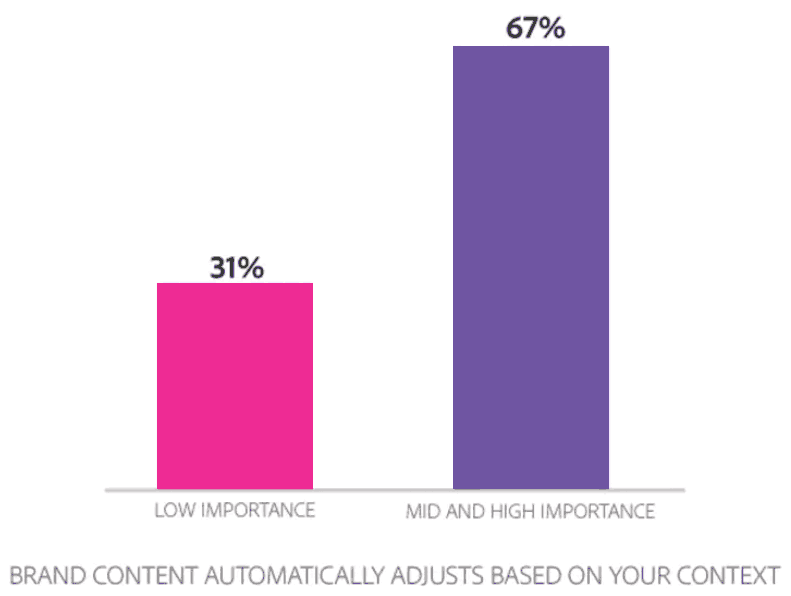

Oct 04, 2021
The future of personalization is here. It’s time for marketers to embrace AI and Digital Asset Management to personalize at scale and lift revenue.
Personalization is not new. The idea was born in the 1980s with the concept of “relationship marketing,” a term coined by Leonard Berry, marketing professor at Texas A&M University.
In the 1990s we witnessed the rise of email marketing, the perfect opportunity for personalized marketing. For the first time, marketers could create segmented drip campaigns that catered to specific audience segments, rather than a one-size-fits-all-approach.
Personalization has come a long way since basic list segmentation and first name “personalization,” but there is still so much more potential. In fact, personalization is poised for a bit of a renaissance here in the near future, as organizations lean into AI-powered software that enables truly personalized, 1:1 marketing, across multiple channels.
The tools to achieve some level of individualized personalization have been around for some time, and many organizations have invested in them. The problem isn’t investment. It’s actually using that investment. Too many companies are still only using the most basic elements of personalization, instead of leveraging these tools to make a tangible impact on customer relationships and revenues.
To make matters worse, marketers now need to consider an increasing number of privacy concerns and regulations — from GDPR to CCPA and 40 other state-level laws on the horizon — and adapt their approach to personalization accordingly. A frustrating problem just got maddening.
To succeed and personalize at scale, businesses must embrace AI, and advance from people-powered personalization to machine-powered personalization. To do this, it’s helpful to understand the history of personalization, where the challenge lies today, and how to think about solving it within your organization for your audience.
Personalization History 101: Cookies and Humans
For the past decade, personalization has relied heavily on two things: data provided by behavior-tracking technology such as cookies, and the humans who set up manual logic to serve personalized experiences based on that data.
Using this data, marketers can then create audience segments manually, often in a spreadsheet. These segments can be reasonably complex, including a range of information like customer status (e.g. new vs. returning), demographics (e.g. age, household income, education), and location.
Once the segments are defined, marketers are then tasked with a herculean request: creating unique marketing assets for each segment; in a variety of image formats and dimensions to meet the requirements for all the placements and channels they’ll be distributed to; and all the supporting content for those images, like headlines and body text.
For example, an energy drink company may have a national campaign targeting a set number of personas. They would develop creative assets for a segment of gym owners. Then, they’d have to get those assets resized, saved, and distributed to each channel they’re using in the campaign. Google Ads alone has over 60 different image specs — and that’s just Google. Marketers then have to repeat the process for every other channel supporting the campaign, from print media and billboards to Facebook and Instagram. Don’t forget that they have to produce all the supporting copy and headlines for each channel, too. When they’ve finally finished, they start over with the next persona, be it personal trainers, marathon runners, or those of us just trying to get through the day..
It’s easy to see how this creates a massive amount of assets for marketers to produce and keep track of — let alone have to edit and update. It becomes increasingly unmanageable. Human marketers can only work so many hours in the day.
Moreover, this method of personalization is extremely limited. Because it relies on literal human power, brands are forced to personalize by personas. Personas are still just large groups of people, however segmented they become. They’re not truly personalized to the individual.
And therein lies the problem: today’s customers expect an individualized experience. 67% of consumers expect brands to automatically adjust the content they see, based on their current context for a real-time personalized experience, according to research from Adobe. To meet their demands, brands must transition from personalizing content for personas to individuals.

A New Day In Personalization Is Upon Us: AI Enters the Chat
Enter 2021. Organizations now have access to the technology that allows them to personalize, on an individual level, in real time and at scale.
Instead of spreadsheets and hard drives, we now have Digital Asset Management (DAM) platforms that allow for centralized management of an asset library in the cloud. From a single system, marketers can control the digital rights management around those assets and govern their channel and placement. Marketers can also bulk edit, manipulate, and tag those images in a centralized place, and have those changes carry through to anywhere those assets are consumed and published. Some DAM’s even tag images automatically based on AI algorithms, making it easy to find what everyone’s looking for, without any human effort.
Instead of humans creating the personalization logic, we have artificial intelligence. AI programmatically observes what a person is doing, in real-time (a capability humans never had), and then programmatically serves up the most personalized, conversion-driving asset based on that individual’s behavior. And since the market-leading DAMs can integrate with the best personalization platforms, the AI not only knows the right images to pick from a library, but may even be able to alter an image based on the personalization they’re trying to achieve — without a human ever touching it.
A good DAM will also support multivariate and A/B testing, along with programmatic experimentation, through integrations with digital experience platforms like Optimizely. With this type of integrated solution, AI can infer from a visitor’s real-time behavior that they are a middle-aged white male who lives in Washington, D.C., and then serve them with custom tailored offers, content, images, and more.
This allows for several new flavors of personalization previously not available with personalization powered by humans. Previously, personalization meant swapping out a picture or a piece of content. With these AI-powered systems in place, personalization is truly personal, and it’s done on a deeper, more individualized level to drive conversions.
There’s only one problem. Many digital marketers still don’t even know what Digital Asset Management is, let alone what it can do for them. As a result, companies have continued to rely on limited software and human power to do personalization, leaving their customers unimpressed and their bottom line unimproved.
The Challenge Facing Marketers
Very few companies have been able to achieve personalization in a meaningful way because of the technological limitations of using the wrong software for the job, and the reliance on using people to map out who you’re going to personalize for, creating the logic, and then configuring it into a piece of software that does what amounts to parlor tricks.
Using humans to complete these tasks — the production and management of the assets, as well as the configuring of the logic — is simply not effective.
It’s too slow, and the personalization that results is way too simplistic. At best, you may have a level or two of personalization, which exists in a single channel. For example, a company may have a “Find a Store Near You” locator on their website. In this case software references a GeoIP database, their ZIP code is automatically approximated, and they’re served with a list of locations in their general vicinity. But that’s a cheap trick and it’s not always 100% accurate. It offers some convenience, but it’s not going to materially improve the relationship or move the needle.
That’s the moral of the story: When you rely only on humans, it’s near impossible to launch a personalized experience that’s actually meaningful. Ideally, you’d factor in a user’s real-time behavior on your site, plus their engagement on other platforms, and continually provide an individualized series of experiences throughout their customer lifecycle.
But achieving the ideal scenario only becomes possible when you’re using Content Management, Experimentation, Personalization, and Digital Asset Management (DAM) software that has embraced AI, and is all seamlessly integrated. Only then can companies automatically serve people with not only an image relevant to their location, but one that also speaks to their other psychographic characteristics. Moreover, AI can offer them a relevant promotion based on the content they’re actively engaging with on site. It can go even further, delivering a personalized content experience across channels, with targeted social media ads, email campaigns, and more.
That, in a nutshell, is the future of personalization, and it’s here and now.
The Holy Grail of Personalization: Cross-Channel, Customer Approved
Despite the possibilities, many companies today still only use personalization to take people from point A to point B on a single channel. They’re getting by relying on humans, siloed software, and cookies.
But cookies may very well be rendered useless as privacy laws continue to complicate the landscape. If that happens, companies will be forced to adopt a new form of personalization — a system that works without cookies, abides by the rules of GDPR and CCPA, and personalizes at scale, across channels. Integrated DAMs and experimentation platforms will be essential, as will sophisticated consent mechanisms.
Customers will require increasingly granular control over all the things they subscribe to, the data they allow a company to collect about them, and the manner in which they want that data to be used to target them. The days of one-button consent forms are probably numbered. Today’s basic pop-up will transform into something with lots of checkboxes or toggles which will give everyone granular control over the use of their data.
83% of customers are more than willing to share their data with companies to enjoy more personalized experiences, according to data from Accenture. Where customers hesitate is the tracking of that data across platforms.
So, in many cases, businesses will be limited to personalizing experiences based on a user’s on-site behavior after they’ve opted in to you tracking them. Fortunately, AI-powered personalization and experimentation software, integrated with DAM, can achieve a lot with just that.
Artificial intelligence can see where a user is clicking and scrolling on the site, and knows what those pages and sections represent, and from that can deduce things from that behavior. If the user signs in, then the AI may have even more data that you’ve collected through progressive profiling or past purchase history. The AI is watching, collecting, and deducing until a psychographic (not demographic) profile is developed based on the individual.
Based on that profile, the AI can provide them with personalized content and offers across the channels the user opts in to. It can also inform your marketers about what assets, offers, images, and messaging need to be created. Once your marketers produce those assets, the AI takes it from there, acting as a conductor to distribute and use those assets as needed. The AI becomes even more intelligent and effective with time, accumulating insights and performing endless multivariate tests with each customer to see what drives action.
In the future we’re moving towards, humans will perform all of the production, but the planning, configuration, and distribution of personalization will be delegated to AI. Moreover, AI will streamline the production process for humans, as it can help them prioritize which content to produce first, and provide prompts for what exactly needs to be produced to satisfy the content gaps. That last piece of the puzzle may be a ways off, but that’s where we’re headed, you can be sure of it.
Seize the Future
There’s never been a better time to do personalization. This is the dream we’ve all been chasing, and it’s why you’ve invested in these tools. Now it’s time to take a second look at the tools with fresh eyes and new expectations. It’s time to stop relying on humans to do the work an AI can do better, faster, and smarter. It’s time to embrace the future, and give your customers — and shareholders — what they want: more engagement, more conversions, and more revenue.
Talk to Oshyn for help architecting what that looks like for you.
This site is protected by reCAPTCHA and the Google Privacy Policy and Terms of Service apply.








